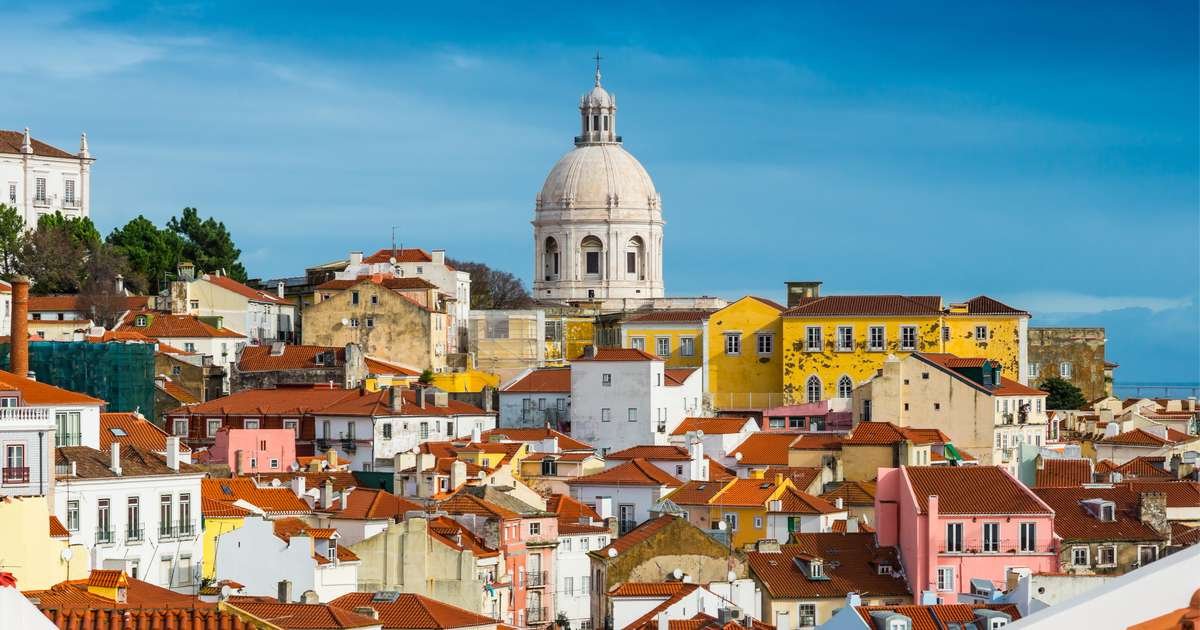Not only is Lisbon the capital of Portugal, but it also holds the title as the second-oldest city in Europe!
Lisbon is a city of stories made of dreamers, explorers and artists. Its cuisine reflects the intermingling of cultures, trade routes and past colonies. It is the birthplace of Fado as well as the beloved pasteis de nata. With such an extensive past comes an eventful history, one so vibrant that it matches the rainbow of colored architecture you’ll discover here.
In this all encompassing list, we have compiled the Top 50 things to do in Lisbon, which will guarantee you see the best of the city. Pick and choose from our suggestions, or even dare to visit them all during your stay in Lisbon.
Other Recommended Articles:
Public Transportation in Lisbon
Recommended Hotels in Lisbon
Things to Do with Kids in Lisbon
Best Restaurants in Lisbon
Shopping in Lisbon

1. Alfama
The heart and soul of Lisbon.
In a city with more than 3000 years of history, this historic quarter has witnessed many events as well as survived the massive earthquake, fires and tsunami which almost leveled all of Lisbon in 1755. As you walk through the maze of narrow cobblestone streets, it will become obvious that what makes this area special is its persistence to maintain a tight community, keeping generations of residents close, both in regard to proximity and relationships.
The village-like district begins along the river and quickly ascends into the hills, promising steep stair climbs followed by breathtaking viewpoints. Get your cameras ready because everything here is picture worthy. It’s a collage of azulejo (traditional tile) covered four hundred-year-old homes, medieval churches, taverns where fado floats from the window, roman artifacts, burgeoning burgenvilia, one of a kind street art murals, scenes of residential Portuguese life and laundry lines that dance overhead. If you get tired from all the walking, hop on the famous tram 28, which rumbles through the center of the neighborhood about every fifteen minutes, carrying passengers to all sides of the city.
Popular Ticket Options:
- Lisbon: History, Stories and Lifestyle Walking Tour
- Best of Lisbon Walking Tour: Rossio, Chiado & Alfama
- Lisbon: Alfama Tour and Live Fado with Traditional Dinner (Recommended)
- Lisbon: National Pantheon E-Ticket & Audio City Tour
- Segway Medieval Guided Tour of Alfama
- Segway Food Tour through Alfama and the Old Town of Lisbon
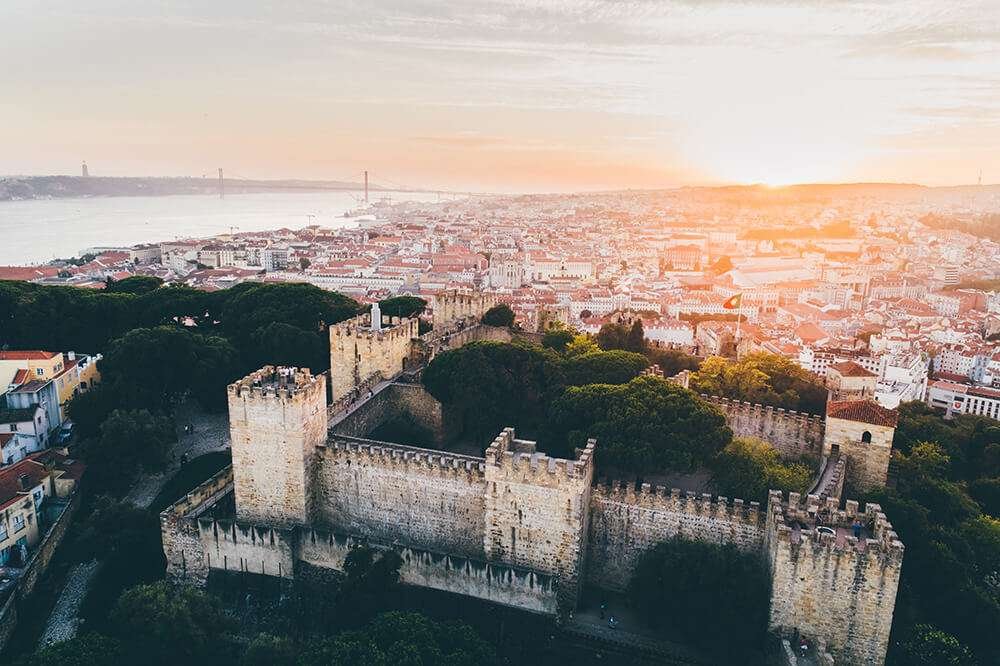
2. São Jorge Castle
Historical castle and citadel established in 200 B.C.
Over the past centuries the landmark castle on the highest hill of Alfama has been rebuilt, strengthened and preserved so that people may enjoy it today. Its location which was intended for defense purposes now offers one of the best views of the city and Tagus River.
The São Jorge complex includes the castle, ruins of the royal palace, a cistern, ancillary buildings, a spacious terrace, big gardens and eleven towers. When exploring the premises, do not miss the small door located on the northern wall. This wall was used for secret messengers to pass through, which earned itself the name, Door of Treason.
- Address: R. de Santa Cruz do Castelo
- By Tram: 28E exit at Lg. Portas Sol
- Discover more about the fascinating past of São Jorge Castle in Lisbon.
Popular Ticket Options:
- Ticket overview for São Jorge Castle
- Skip the line ticket for São Jorge Castle with Guide
- Classic Lisbon Combo: Sao Jorge Castle + Belém Tower + Jerónimos Monastery Tickets (Recommended)
- Combo Ticket: Entrance ticket for the Castelo de São Jorge + Lisboa Card (Bestseller)
- Combo Ticket: Lisbon Oceanarium + Castelo de São Jorge
- Combo: 24-hour hop-on hop-off tour of Lisbon + tickets to St. George's Castle

3. Jerónimos Monastery
UNESCO Monastery dedicated to Vasco de Gama
The 16th century Jerónimos Monastery honors Vasco da Gama, the first Portuguese explorer to complete the journey to India. Before setting sail, Da Gama and his crew stayed at the monastery and prayed in the chapel Ermida do Restelo for a successful and safe expedition.
Jerónimos Monastery is an incredible example of Manueline style and a testament to the wealth and success of Portugal during the Age of Discovery. It is strongly influenced by a maritime theme, and the designs feature discoveries made during empire expansion voyages. Within the monastery are tombstones dedicated to the greatest explorers, poets, kings and politicians in Portugal, with Da Gama’s tombstone near the entrance.
- Address: Praça do Império
- By Train: Belém Station
Popular Ticket Options:
- Ticket Overview for Jerónimos Monastery
- Tickets for Jerónimos Monastery
- Combo Ticket: Jerónimos Monastery + Belém Tower + National Palace of Pena
- Classic Lisbon Combo: Sao Jorge Castle + Belém Tower + Jerónimos Monastery Tickets (Recommended)
- Combo Ticket: SL Benfica Stadium and Museum Tour + Mosteiro dos Jerónimos (Bestseller)
- Combo Ticket: Jerónimos Monastery + Navy Planetarium
- Lisboa Card 50+ attractions + Public transport
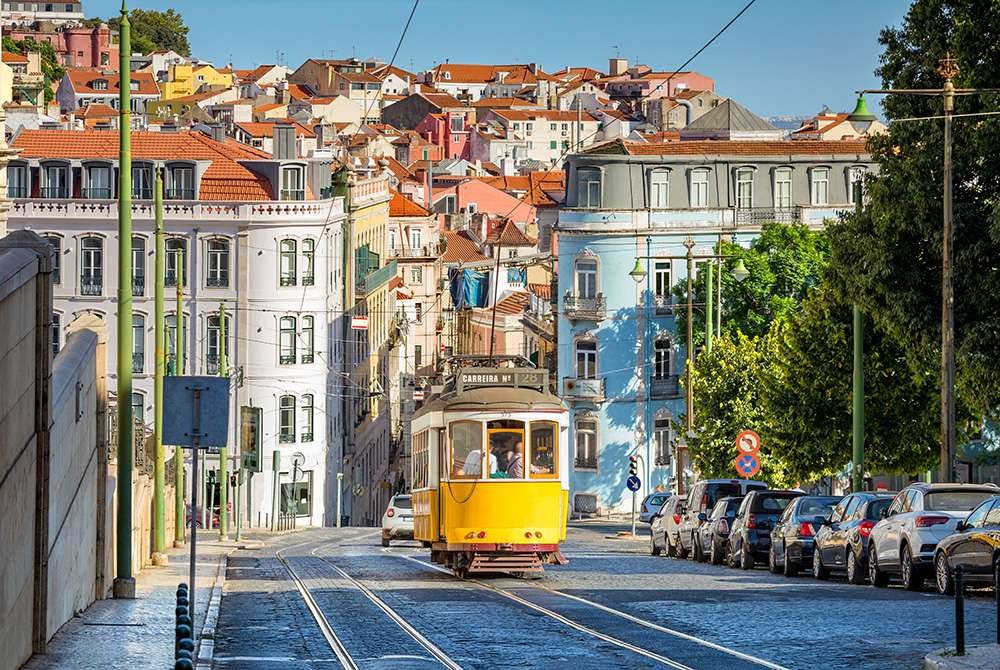
4. Tram 28E
The most widely recognized symbol of Lisbon
The iconic 1930s tram is an image that comes to mind when people think about Lisbon. At almost all hours of the day or night it rambles through the narrow streets of the most popular neighborhoods, making a loop that takes about an hour to cover.
A ticket can be purchased ahead of time or on board. Make sure to carry at least 3 euros worth of pocket change with you to make the transaction quick and easy. Riding the Tram 28E is a classic experience when visiting Lisbon, and can be done as a means of getting from one popular district to another, or just as a ride to enjoy the view. The interior has been maintained to resemble the authentic designs and the ride is as bumpy and full of jolts and halting stops as it was almost 100 years ago.
- Find out all there is to know about the full route of Lisbon's Tram 28E and 25E and Lisbon’s public transportation.
Popular Ticket Options:
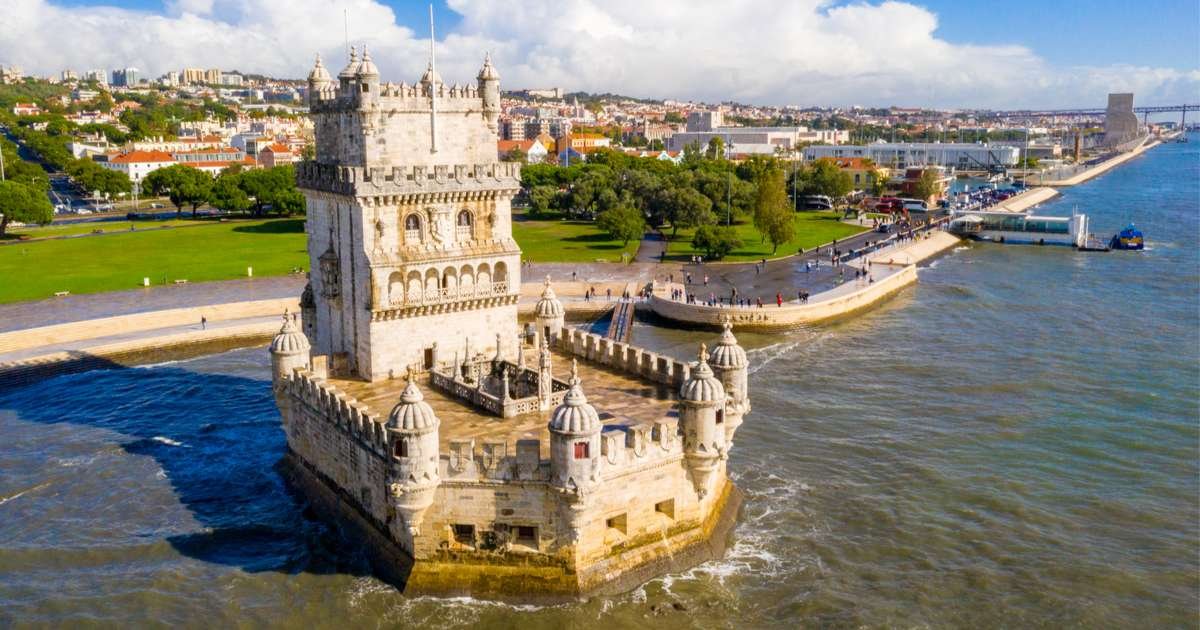
5. Belém Tower
Most famous historical landmark in Portugal.
Designated a UNESCO World Heritage Site in 1983, Belém Tower commemorates the Portuguese Age of Discovery and belongs to the Portuguese historical sites known as the Seven Wonders.
Located on the banks of the river’s opening to the ocean, the limestone tower is built in the Manueline style of the late 16th century. It served as both the ceremonial gateway to Lisbon as well as acted as the defense system for those trying the city from the ocean.
- Address: Av. Brasília
- By Train: Belém Station
- For an in-depth look at the tower, check out our article on the history of the Belém Tower.
Popular Ticket Options:

6. Santa Luzia Miradouro and Church
Viewpoint with stunning church beside it.
The church of Santa Luzia is recognized as a national monument in Portugal, which belongs to the Knights of Malta. On the church’s wall you can admire two azulejo murals which depict historical scenes from Lisbon’s past. Painted in blue on glazed tiles are the palace and Praça do Comércio before the catastrophic earthquake, as well as Saint Luzia and a famous 12th century battle at Sao Jorge Castle.
While the church is noteworthy, it is the lookout point, the miradouro, that is truly spectacular. Head to the terrace to be rewarded with a view that stretches as far as the eye can see, making it possibly the most popular miradouro in Lisbon.
- Address: Largo Santa Luzia
- By Tram: 28E exit at stop Miradouro Sta. Luzia
- → Interested in discovering more of Lisbon's best views? These picture-perfect locations will leave you breathless!

7. Lisbon Cathedral
The Biggest and oldest cathedral in Lisbon.
First constructed in 1147 by the Christian Crusaders, the Lisbon Cathedral, also called Se Cathedral or simply Se, was an initiative of King Afonso Henriquez, who defeated the prior Alfama residents, the Moors. The cathedral pushed religion to the center of the Portuguese community and became the site for significant gatherings of the wealthy elite and noble classes.
Like many structures in Lisbon, it suffered damage from the earthquake and many parts required restoration, resulting in a fantastic combination of architectural styles. On display are artifacts found in the courtyard, believed to be more than 2000 years old. Be sure not to miss the treasury, which contains jewels, suits, and relics from Portuguese history.
- Address: Largo da Sé
- By Tram: 28E exit at stop Limoeiro
- Read more about Lisbon Cathedral and Lisbon’s most famous churches and monasteries in this article.
- Get your ticket for Lisbon Cathedral (Sé de Lisboa) in advance here!
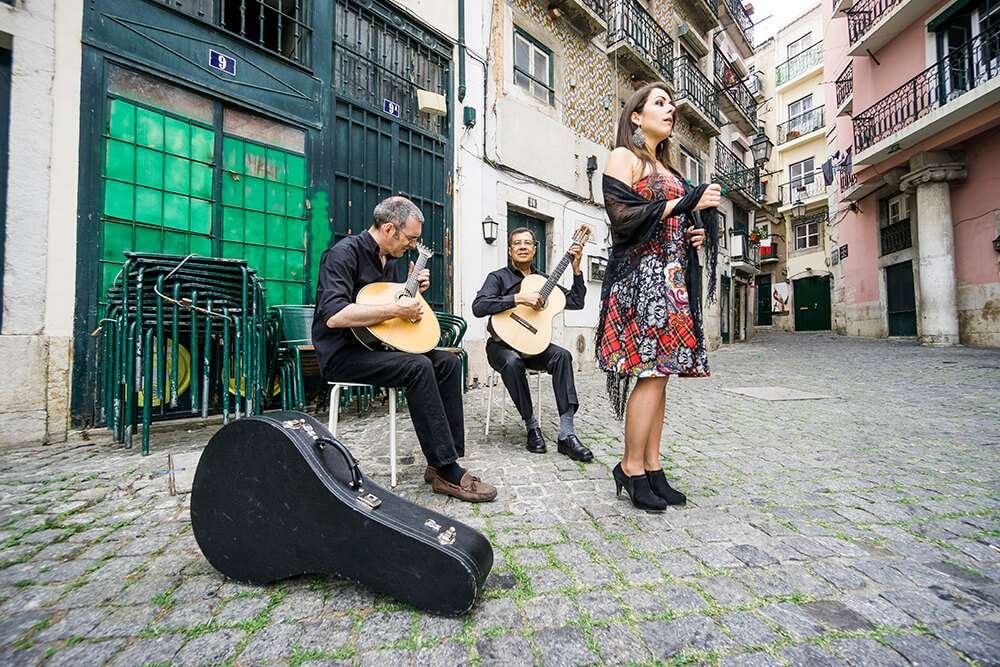
8. Fado Shows
Experience traditional Portuguese music
Fado is the famed music of Portugal which tells stories of history, tradition and of course, heartbreak. It became popular in the 19th century as women sang pain-filled love songs for the men who had gone on seafaring journeys with no certainty of return.
What makes Fado unlike other music and specific to the history of Portugal is that it evokes feelings of melancholia, passion and saudade- the emotion of missing something that no longer exists. While you can see the music performed all over Lisbon, a walk through Alfama will introduce you to many historic restaurants which organize Fado shows.
- Check out our guide to Nightlife in Lisbon to plan an unforgettable night out!
Popular Ticket Options:
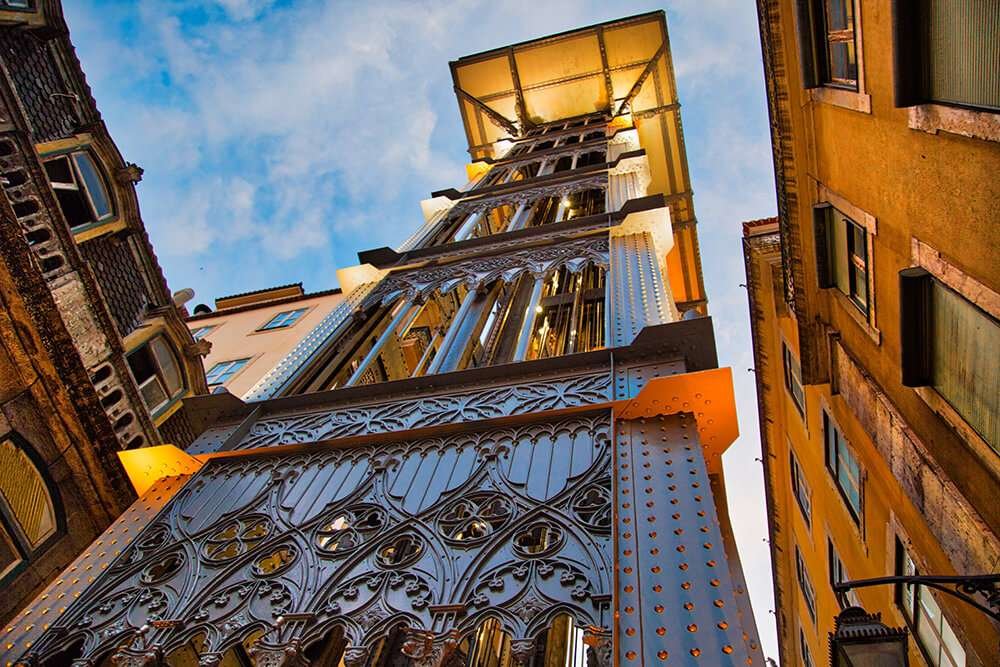
9. Santa Justa Lift
Wrought-iron elevator with stunning view
The Santa Justa Lift can be seen from many points in the city as it stands at over 145 feet tall. The wrought-iron elevator stretches into the sky, carrying passengers from the ground to the upper area of Largo do Carmo.
Inaugurated in 1902, the elevator first operated with a steam engine until being replaced five years later with an electric motor. Designed to mimic aspects of the Eiffel Tower, it is as much a practicality as a work of art. At the top of the elevator is a viewing deck which is free to access and provides spectacular views of Lisbon.
- Address: R. do Ouro
- Discover more about the history of Lisbon's Santa Justa Lift.
Popular Ticket Options:

10. Pastéis de Belém
Most famous bakery in the country
No trip to Lisbon is complete without tasting the country’s prized dish, pastel de nata. Pick up a bag to go or stay for an espresso and enjoy the old-world charming décor of Pastéis de Belém.
The sweet and savory palm-sized pasty is packed with as much history as it is flavor. During the Medieval Ages in Portugal there was a large demand for egg whites which were used by the convents and monasteries for starching clothes. Faced with the dilemma of unused yolk, bakers began to get creative and eventually the pastel de nata was born! It is the most famous dessert in the country and since 1837 Pastéis de Belém has held and protected the original recipe.
- Address: R. de Belém 84 92
- By Train: Belém Station
- Buy your tickets for a Pastel de Nata cooking class in Lisbon here!

11. Lisbon River Cruise
A unique way to experience Lisbon's charm is from the water. On a Lisbon River Cruise, you can glide along the Tagus River, soaking in stunning views of the city's iconic landmarks like Belém Tower and the 25 de Abril Bridge.
You can choose from various options like Day, or Sunset boat tours, sailing yacht cruises or even dolphin watching boat tours. Whether it's soaking in the sunset hues or encountering marine life, these cruises promise an unforgettable experience in Portugal's capital.

12. Portuguese Seafood Dinner
Indulge in a traditional meal served in a family style-tavern.
It was under Roman rule that Portugal began to expand as a fishing industry and today, across the city, you will find countless restaurants all serving large dishes of grilled fish and fresh seafood.
When in Portugal, you must try their salted cod, bacalhau. It has been part of Portuguese cuisine for centuries and has its roots in their seafaring past as a food preserved for long voyages. The cod is served in hundreds of ways which means you never have to repeat an order! Another favorite is polvo à lagareiro, a dish of buttery soft octopus served with a side of roasted potatoes. Topped with a heavy serving of regional olive oil and garnished with black olives, it's a meal you'll want to order again!
- Check out our list of top seafood restaurants in Lisbon!
Popular Ticket Options:
- Lisbon: City Walking Tour with Tasting and Drinks
- Embark on a Guided Foodie Tour with Wine (Bestseller)
- Traditional Portuguese Cooking Class
- Pastel de Nata cooking class
- Lisbon: Alfama Tour and Live Fado with Traditional Dinner (Recommended)
- Wine Tour of Èvora from Lisbon
- Segway Food Tour through Alfama and the Old Town of Lisbon

13. Time Out Market
Hop from stall to stall sampling Lisbon’s greatest foods and drinks
Visiting Mercado da Ribeira, also known as Time Out Market, is a must for all traveling foodies and anyone looking for a great meal or snack.
Established in 1882 and located within a giant waterfront building, Time Out Market has a variety of stalls selling Portuguese favorites, fusion foods and vegan and vegetarian options. There are more than thirty options to choose from, which range from restaurants to bars, coffee shops with pastries and stalls selling fresh produce, fish, meats, cheese and flowers. Everything is made from the freshest ingredients and local products, resulting in both sustainable and healthy options for a meal. There are many stalls run by famous Portuguese chefs and a handful of the food options have been voted best in the city, so take some time to wander down the different aisles, checking your options before making a fast choice.
Address: Av. 24 de Julho 49
- Portugal is home to a culinary culture rich in history. For guidance on what to eat and where, check out our list of the Best Restaurants in Lisbon.

14. Sintra
An unmissable day trip out of Lisbon
If you love mountain top palaces, colorful extravagant architecture, fairytale like castles, overgrown gardens and breathtaking views then Sintra cannot be skipped. Located a short distance outside of Lisbon, it can easily be reached by car or public transportation and is an unforgettable way to spend a day.
The historic town is a very popular destination and many tours are offered to help you make the most of your time here. Some of the highlights of Sintra that we suggest seeing are the National Palace of Sintra, Quinta da Regaleira, Pena Palace, the historic village and Castelo dos Mouros.
- By Train: There is a train that leaves from Rossio Station every 40 minutes that goes directly to Sintra.
- There is a lot to see in their majestic little town, and our Guide to Sintra will guarantee you discover it all!
Popular Ticket Options:
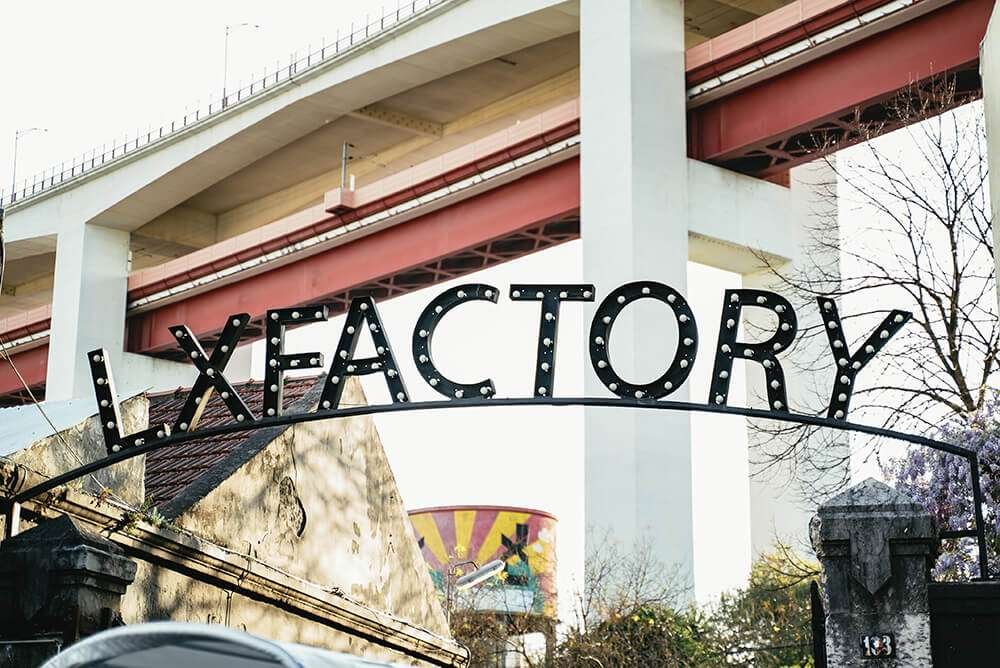
15. LX Factory
Art warehouse district with trendy bars, cafes and boutiques.
Located in a historic and industrial complex, LX Factory has brought new life and energy to once a neglected area of Lisbon.
LX Factory offers more than just shopping and food opportunities, with unique creative vendors such as an ax throwing bar, rotating exhibitions of experimental local artists, vintage furniture dealers and the bookshop, Ler Devagar, which includes a record section, fully stocked bar and old printing machines. The cool factory at LX Factory is high and its many murals and walls of street art only enhance the ultra urban vibe of the area.
- Address: R. Rodrigues de Faria 103
- By Train: Exit at Alcantara station
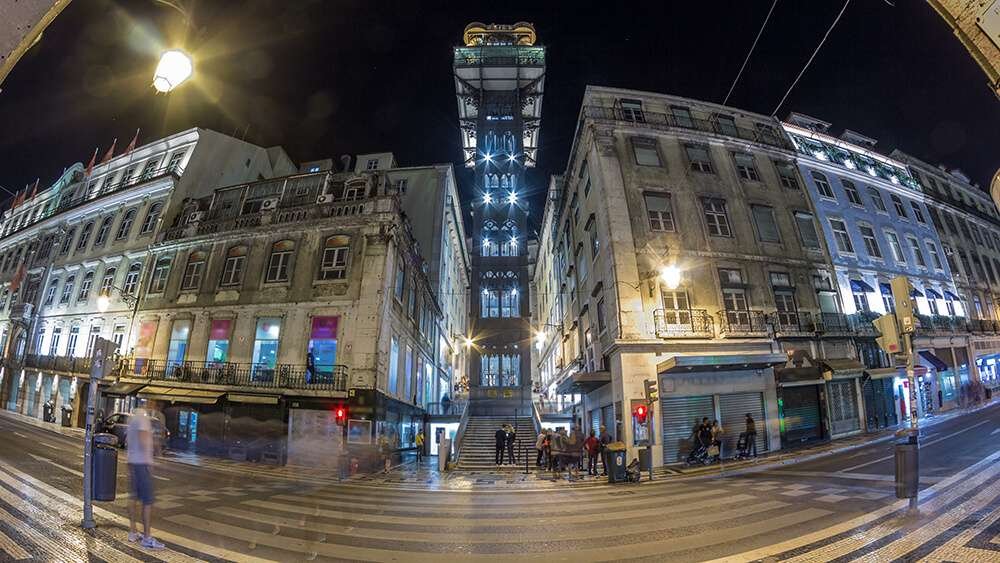
16. Bar hopping in Bairro Alto
A night out in the lively district.
Visitors to Bairro Alto are often surprised to see how the quiet and calm streets of the hilltop neighborhood fill with people and music as soon as the sun sets. Boasting a reputation as Lisbon’s party district, Bairro Alto is the perfect place to experience an unforgettable night.
Whether you're in the mood for a fusion food dinner, cocktails on a rooftop, cheap beers in the street or a live band/DJ to dance to, this is where you want to be. While there are countless places to eat and drink, we suggest starting at Zé dos Bois gallery (ZDP) , which functions as a cultural center, art space and bar that organizes events for music and performance. It's a great location to feel the pulse of Lisbon and from there you can hop from venue to venue.
- Address: ZDP, Rua da Barroca 59
- Looking for more nightlife suggestions? We have you covered in our Guide to Lisbon's Nightlife Scene.
Popular Ticket Options:
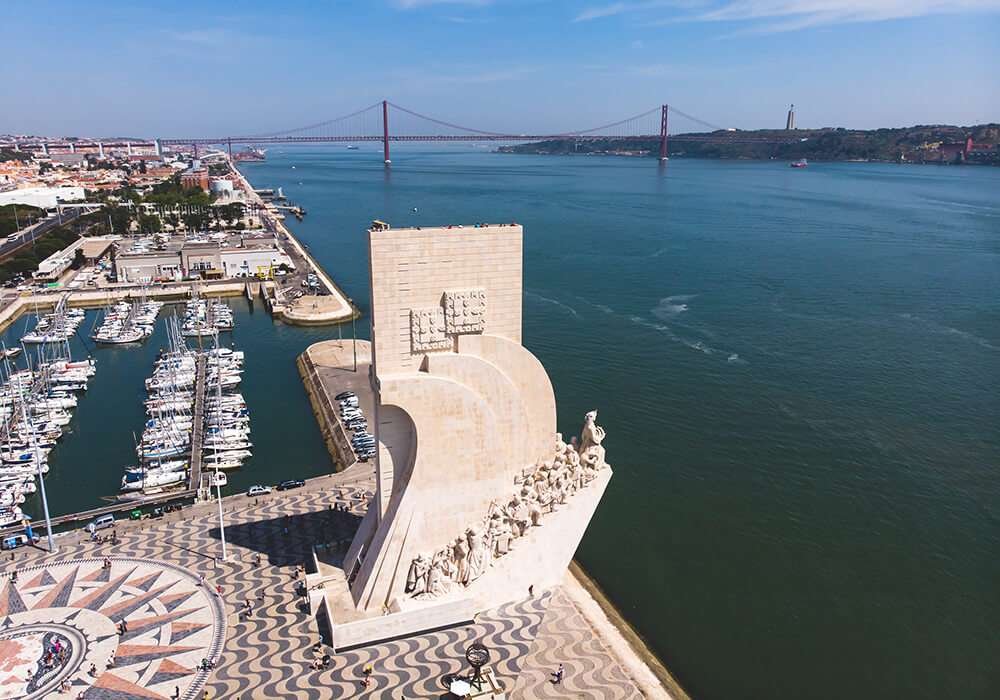
17. Monument to the Discoveries
Testament to the Age of Discovery in Portugal.
The 170-foot tall Monument to the Discoveries was built for the 1940 Portuguese World Fair. It symbolized the 15th and 16th centuries’ Age of Exploration, led at the front by Henry and Navigator.
The monument found its permanent resting place along the Tagus River at the point where ships once departed for voyages. It serves as a permanent memorial to the discoveries made by Portugal under the direction of Henry and the overseas expansion that occurred for the country. At the foot of the monument you will see a large 164-foot marble mosaic compass with a world map at the center.
- Address: Av. Brasília
- By Train: Belém Station
- Explore more of Belém and the city with our Three Day Guide to Lisbon.
Popular Ticket Options:

18. Rua Augusta Arch and Shopping District
The Monumental arch marks the beginning of Rua Augusta street.
Inspired by the designs of Roman triumphal arches, Rua Augusta Arch took over 120 years to complete. The structure commemorates the reconstruction of the city after the tragic 1755 series of disasters.
Standing at more than 100 feet tall, with pillars reaching almost forty feet high, Rua Augusta Arch is decorated with allegorical statues, national emblems and symbolic motifs. It marks the beginning of Rua Augusta which is the busiest pedestrian street that crosses through the central area of the city. Shopping, restaurants, hotels, boutiques, pastelarias and bars all line this patterned black and while stone street.
- Address: R. Augusta 2
- By Tram: 28E or 25E exit at Pç. Comércio
- The Baixa district is one of the most popular neighborhoods for booking hotels. Check out our suggested list of the Best Hotels in Lisbon.
→ Booking an event, conference or wedding? Let our M.I.C.E team assist you with reservations and discounts.
Popular Ticket Options:
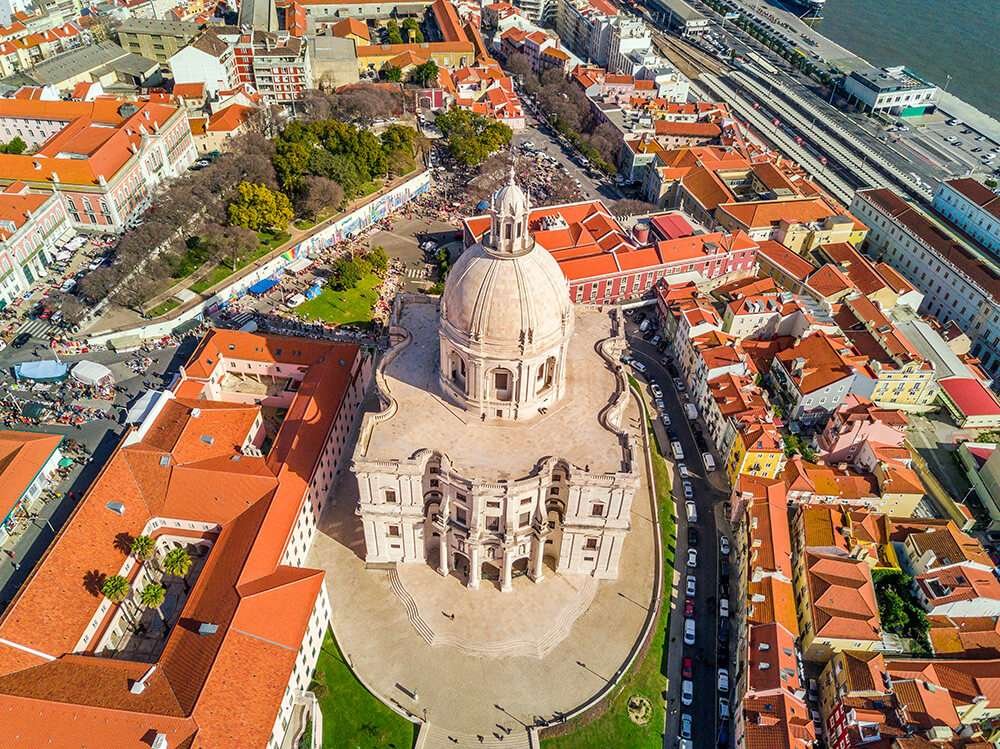
19. National Pantheon
Final resting point of many significant portuguese figures
The National Pantheon is a beautiful 17th century church with a dome that pops out above its neighbors. It took more than 300 years to build and defied a curse which predicted the building would never be completed.
The interior architecture is an example of magnificent artwork with colored marble stonework floors, symmetrical patterned decorations and decor common in traditional Islam. The viewpoints from the location are fantastic and allow visitors to see as far as the Vasco da Gama Bridge.
- Address: Campo de Santa Clara
- By Tram: 28E and exit at Cç. S. Vicente
Popular Ticket Options:
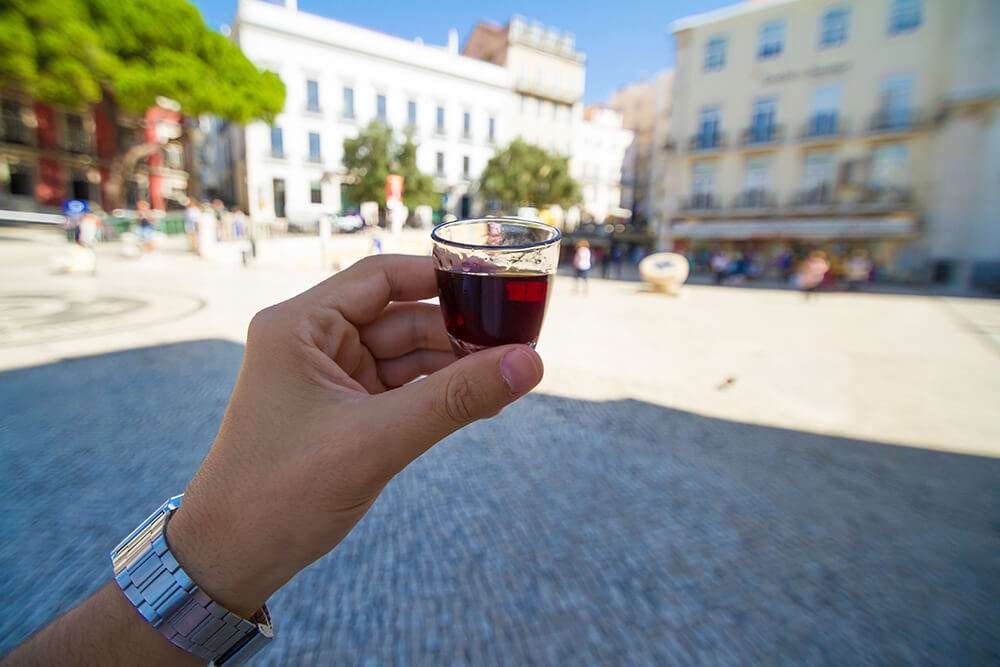
20. Ginjinha
Enjoy a shot of Portugal’s traditional liquor.
The most famous drink in Lisbon is the syrupy red liquor ginjinha which was first served at the traditional bar, A Ginjinha. It’s made from Morello sour cherries, strong distilled alcohol and copious amounts of sugar. It’s often served in a chocolate shot glass, which you can absolutely eat afterwards!
There's not a bartender in Lisbon who doesn't have it on their shelves and you’ll see that some of Alfama’s residents even sell homemade ginjinha straight from their front doors. Enjoy a glass or two, but be warned- the liquor is very potent. It's served at almost all of the Top 10 Bars in Lisbon.
- Address: Largo São Domingos 8
- Sample the delicious drink, and many other local flavors on the culinary tour: Taste the Tradition of Lisbon on a Guided Food Tour

21. Chiado District
Ideal for shopping and having your photo taken beside Ascensor da Bica
Chiado is one of the most popular areas in the city for shopping, restaurants and spending time outside. You’ll find all the big name stores and top eateries here, making it desirable with locals and tourists.
One of the most famous attractions of the Chiado neighborhood is the Ascensor da Bica. The funicular carries passengers up and down the steep hills of the city, connecting one district to another. Take a ride on it but be sure to get the transportation ticket in advance to save money. It's mandatory that you capture at least one photo in front of this historic car, but be warned, there will most likely be a line. This graffiti painted vehicle is sought out by almost every tourist in the city.
- Address: Ascensor da Bica, Rua de S. Paulo 234
- By Tram: 25E exit at Rua De São Paulo / Bica
→ → Chiado is one of the top neighborhoods in Lisbon for hotel bookings. Find out why!
Popular Ticket Options:
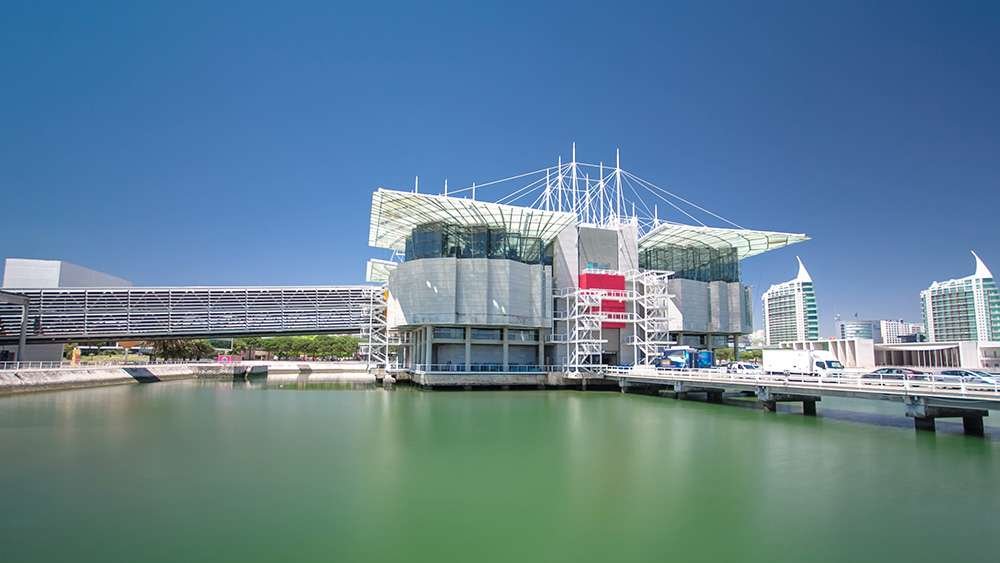
22. Oceanarium
World class aquarium
Dive into the underwater world of the Lisbon Oceanarium. A great visit for all and especially those traveling with children, the Oceanarium offers a full day of entertainment.
With thousands of sea life animals on display and one of the largest aquariums in all of Europe, the center introduces visitors to the different species that live in our seas and oceans. Underwater tunnels and massive tanks create the feeling that guests are really in the ocean with the animals. The organization of animals into differing ecosystem tanks allows people to discover their habitats more closely and the variations in ocean life.
- Address: Esplanada Dom Carlos I s/nº
- By Bus: Take bus 728 which departs from Cais de Sodré and stops at Oceanário Lisboa
Popular Ticket Options:
- Ticket Overview Oceanário de Lisboa
- Ticket for Oceanário de Lisboa
- Lisbon Oceanarium: Entry Ticket + 48-Hr Hop-on Hop-off Bus
- Combo: Lisbon Oceanarium + Telecabine cable car tickets
- Combo Ticket: Lisbon Oceanarium + Castelo de São Jorge
- Combo: Lisbon Oceanarium + Pena Palace + National Palace of Sintra (Bestseller)
- Combo: Lisboa Card + ticket for the Lisbon Oceanarium
- Combo: Lisbon Oceanário + SL Benfica Stadium and Museum Tour
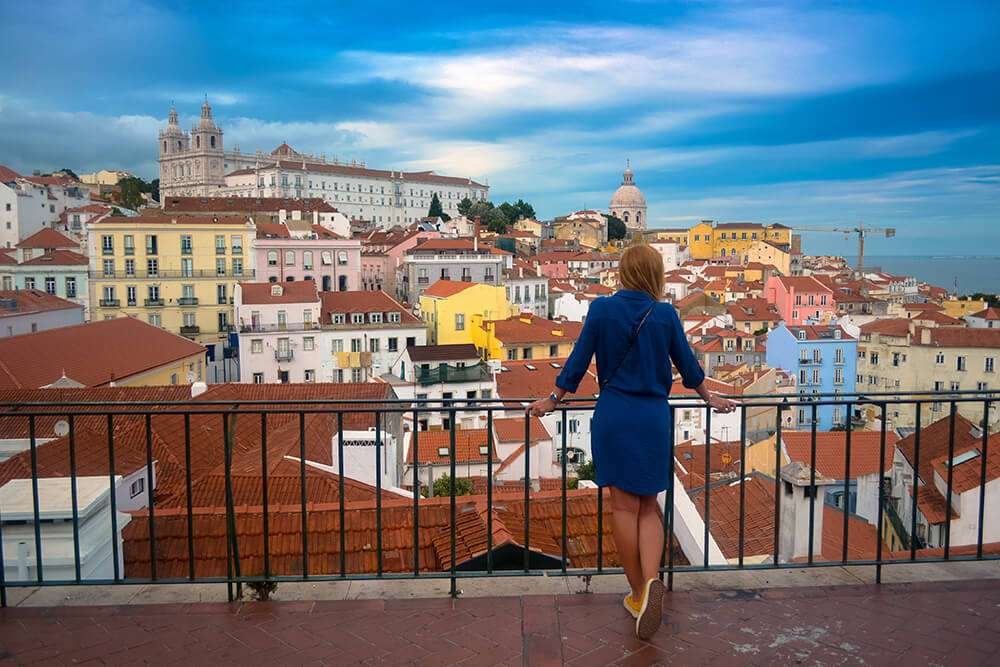
23. Portas do Sol Miradouro
Impressive viewpoint with a popular kiosk.
From the viewpoint balcony, visitors are greeted with a view that stretches across Alfama, down to the Tagus and to the opposite bank of the river. This area is sought-out for postcard worthy photographs as it includes a great shot of São Vicente de Fora Monastery and a sea of rusty colored terracotta rooftops.
Also enjoying the view is the patron saint of Lisbon, Saint Vincent, who has been honored in statue form. The kiosk beside him offers the ideal spot to relax, order a pastry or sip on a chilled glass of fruity sangria. It's common for street musicians to gather here and perform for those nearby or just passing along. It’s a reminder to take a break, grab a seat and appreciate the slow pace of life in Lisbon.
- By Tram: 28E exit at Lg. Portas Sol
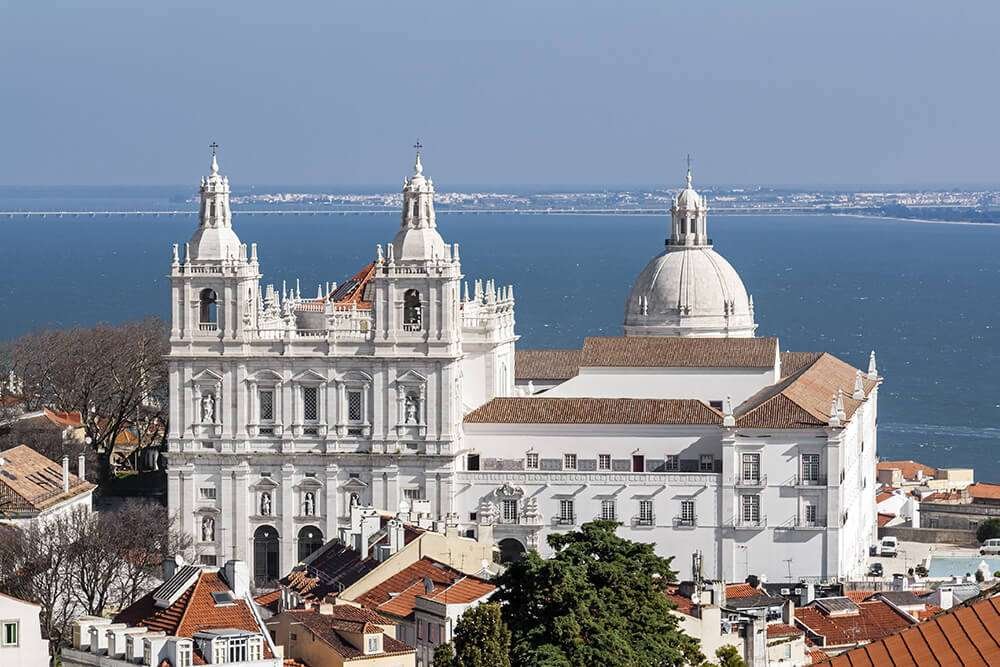
24. Church of São Vicente de Fora
Monastery to the Patron Saint
Built in the 17th century, the late Renaissance style church is dedicated to Lisbon’s patron saint, Vincent of Saragossa. The interior decoration of São Vicente de Fora consists of beautiful works of polychromatic marble, azulejo covered cloisters, tiled murals, painted ceilings and sculptures completed by famous Portuguese artists.
The monastery holds the pantheon of the monarchs of the House of Braganza, the family dynasty which ruled Portugal for 250 years. It includes a fantastic collection of priest's clothing, paintings, gold and sculptures.
- Address: Largo de São Vicente
- By Tram: 28E exit at stop Voz Operário
- Tickets for the Mosteiro de São Vicente de Fora are available here.

25. National Azulejo Museum
Admire the tiled architecture in Lisbon and discover more at the museum.
Glazed tiles, or azulejos, became popular in Portugal in the 13th century, and as the country experienced more outside cultural influence, trade and effects of globalization, the tiles became more colorful and intricately designed.
Walking the streets of Lisbon can leave one feeling as if they are in an open air tile museum, as many buildings are elegantly decorated with them. For a closer look at their history and relationship with the Portuguese, head to the National Azulejo Museum, situated within the former Madre de Deus Convent. The tiles on display tell stories from Portugal’s past with displays of religious art, legends, altarpieces, colorful maps, fairy tales, nature, hunting scenes and rooms tiled from floor to ceiling.
- Address: Rua Me. Deus 4
Popular Ticket Options:

26. Berardo Culture Center
Center for Performing Arts.
The BCC is the largest venue in Portugal for gatherings and hosts different exhibitions, performances and cultural events. It was originally built to host Portugal's presidency of the European Union in 1992 but expanded to become the cultural hub it is today.
Inside the free-to-enter Berardo Collection Museum are more than 1,800 pieces of art on display, donated by the wealthy Portuguese businessman, Joe Berardo. His impressive collection includes works by Warhol, Miró, Pollock, Picasso, Dali and other modern artists.
- Address: Praça do Império
- By Train: Belém Station
- Check out our list of the 10 Best Museums in Lisbon.
- Interested in other sights in Belém? Explore the impressive district on a bike tour! Book one of the most popular bike tours through Belém here!
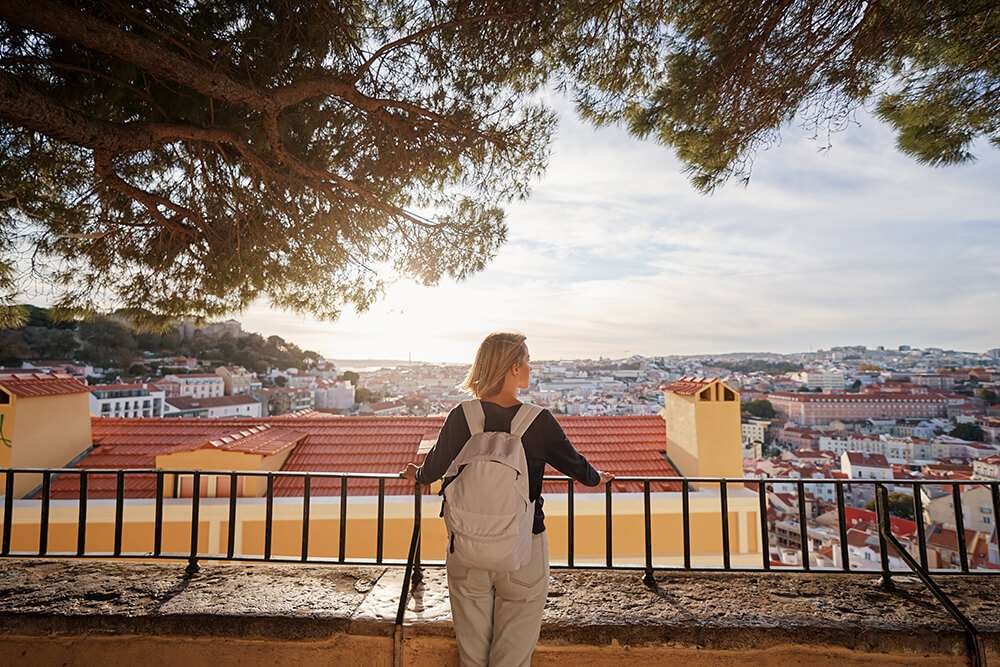
27. Graça Miradouro
Viewpoint with a thriving kiosk
One of the benefits about exploring a city with as many hills as in Lisbon is that with each slope you climb, at least one view is waiting for you- and the view from Graça is not one to be missed. Situated beside the Igreja da Graça, originally constructed in the 13th century, and above the popular park by the same name, the Graça miradouro is a favorite with locals and visitors and the cafe is always buzzing with customers.
The viewpoint from Graça offers visitors a chance to see the castle, point out the peeping dome of Estrela Basilica and admire the 25 de Abril bridge. You’ll often find artists here working under the shade of the pine trees, each trying to capture the enchanting magic of Lisbon.
- Address: Calçada da Graça
- By Tram: 28E exit at stop Lg. Portas Sol
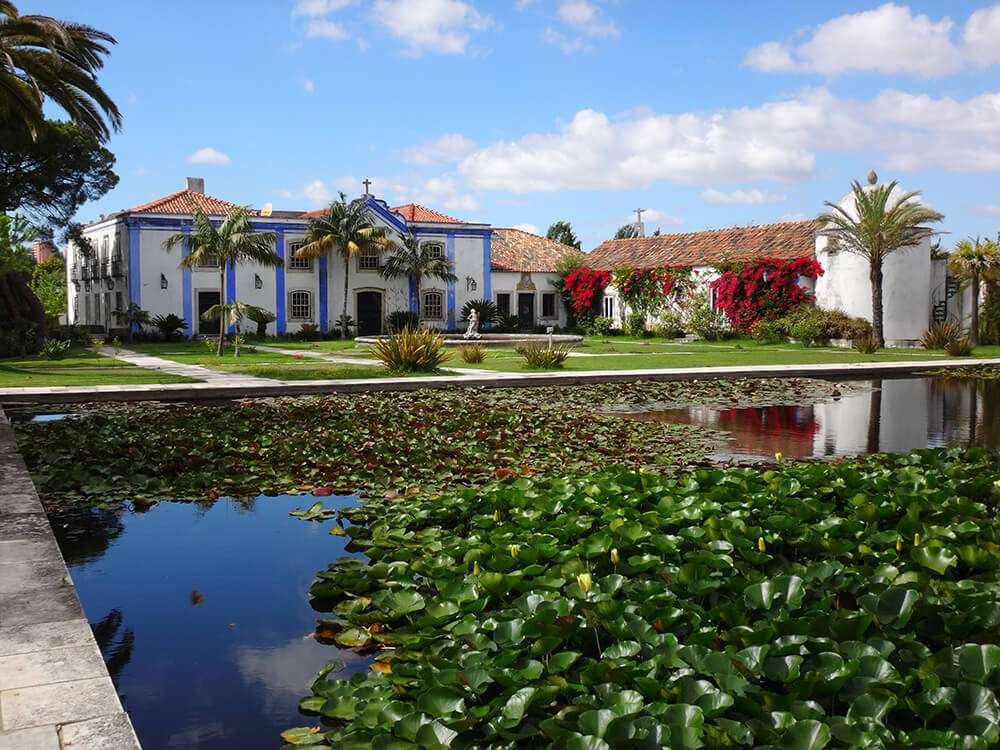
28. Tropical Botanical Garden
Seven hectares of lush greenery
The Tropical Botanical Garden was established by King Charles I in the early 20th century with the intention of preserving rare plants at risk of becoming endangered. The garden was showcased in the 1940 Portuguese World Fair to exhibit what the country had acquired from past colonies.
Today the garden is managed by the Institute for Scientific Research which aims to promote the study of plants found abroad, mostly from tropical and subtropical regions. Enjoy a leisurely stroll through the garden and see if you can spot the rare dragon trees!
- Address: Largo dos Jerónimos
- By Train: Belém Station
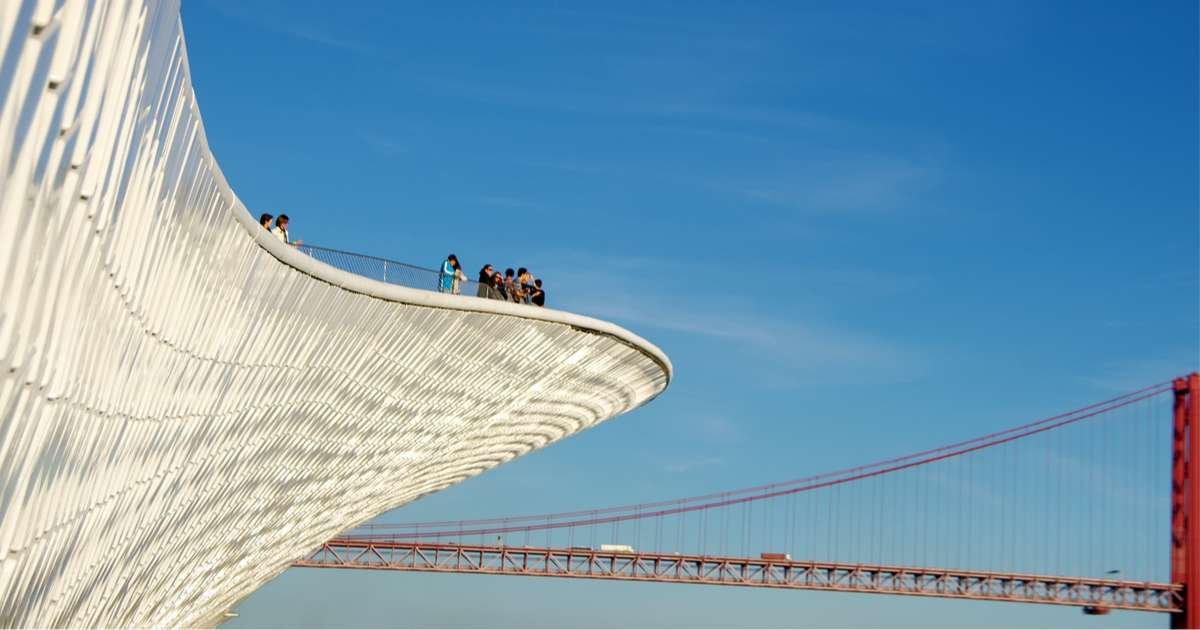
29. MAAT Museum
World-class work of architecture with provoking exhibitions
Located beside the Tagus river, the Museum of Art, Architecture and Technology not only offers a beautiful waterfront view but also the opportunity to experience rotating exhibitions.
The modern cultural center is a great option for families traveling together, solo tourists or couples. The exhibitions provoke discussion, critical thinking and imagination which engages visitors of all ages.
- Address: Av. Brasília
- By Train: Belém Station
- Admission: Tickets to MAAT Gallery and MAAT Central
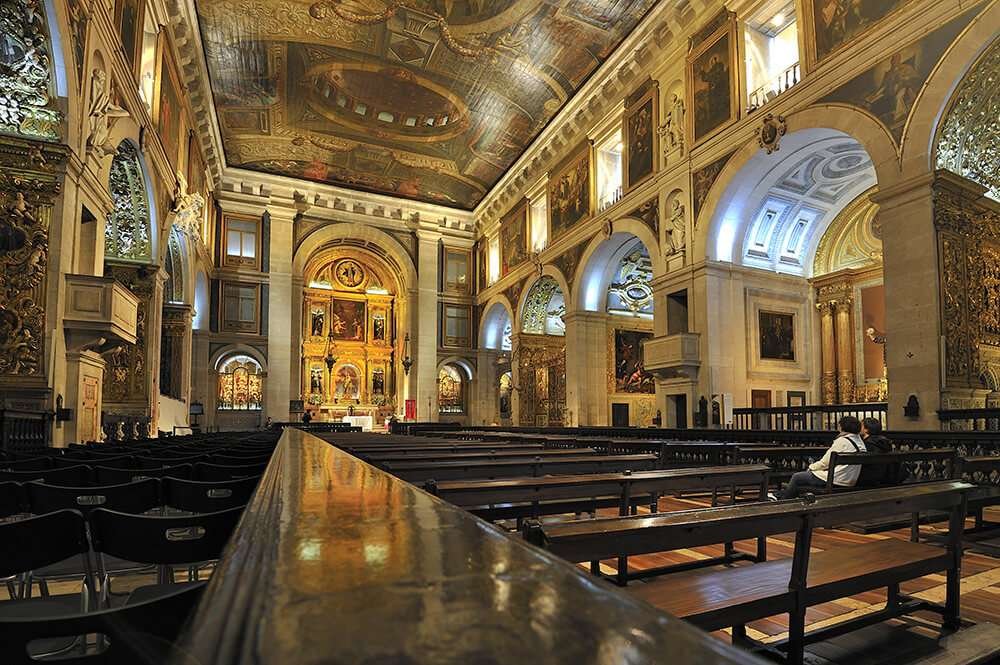
30. Church of Sao Roque
Served the Jesuit community for 200 years before exile
Sao Roque is the first Jesuit church in Portugal as well as one of the earliest Jesuit churches in the world. It is one of the few structures that survived the catastrophic events of 1755.
Built in the 16th century, Sao Roque was named after the saint who helped heal the sick and victims of the plague. A visit inside surprises visitors with a fusion of architectural styles that radiate with wealth. Above the golden altars is a magnificently painted ceiling with scenes of the Apocalypse. Also on display is rumored to be the most expensive chapel ever built. It was transported from Rome to Lisbon by ship, after receiving the Pope's blessing.
- Address: Largo Trindade Coelho
- By Tram: 28E exit at Pç. Luis Camões
- Dive into Portugal’s religious history and discover more about the churches and monasteries of Lisbon.

31. Feira da Ladra
Eclectic flea market with antique dealers.
Organized every Tuesday and Saturday, the open air market Feira da Ladra offers visitors the experience of walking through rows of eye-catching stalls selling every kitsch trinket and household nicknack one could dream of. From recycled clothes to vintage jewelry, handmade art and valuable antiques, you’re bound to find it here.
Originally named Thieves Market, this attraction is popular for those looking to do a bit of shopping, browsing, photography or just grab a coffee and walk. It began in the 13th century and was hosted in different locations around the city before eventually finding its permanent home behind the São Vicente de Fora monastery. Prices at the stalls are almost always negotiable and it offers the perfect opportunity to find something small to take home as a souvenir, such as an azulejo.
- By Tram: 28E exit at stop Voz Operário
- Looking for the best shopping and souvenir ideas in Lisbon? We’ve got you covered!
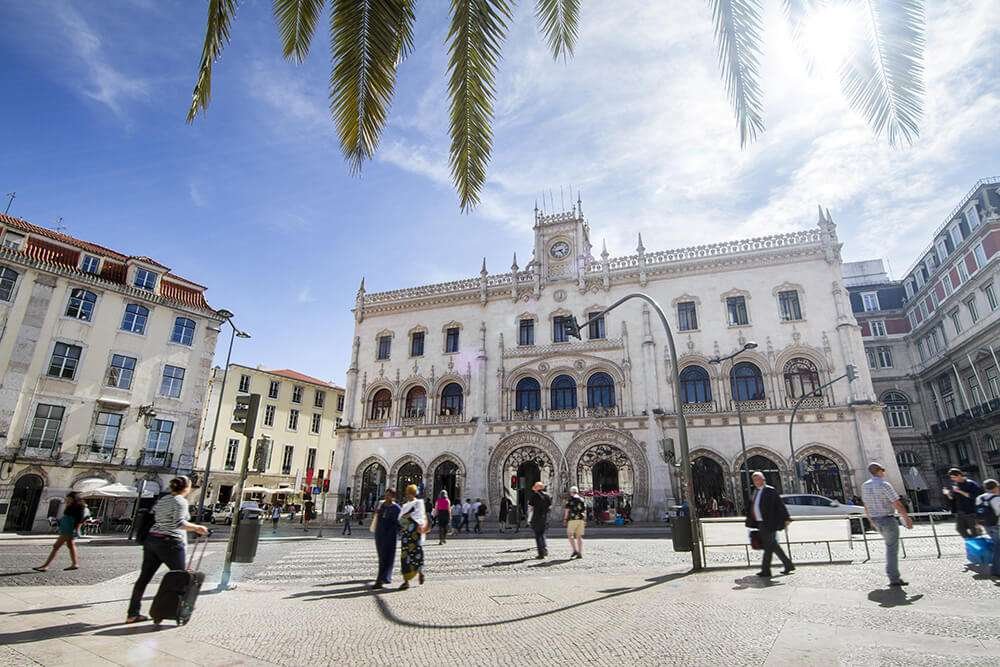
32. Rossio Station and Plaza
The city’s central plaza and monumental train station.
Rossio Station, where trains depart for Sintra, is a remarkable example of Neo-Manueline architecture and is essential to see on any visit to Lisbon. The attention to design that was given to the train station was equally given to the plaza and fountain.
Since the Middle Ages, Rossio Square has been a popular meeting point for locals and foreigners. The name Rossio actually means “commons,” as this space was considered a gathering area for the common crowds. Today it draws people in for shopping, dining and photo opportunities. The entire area is paved in a wave-like pattern which was inspired by the country’s relationship with the sea and has two beautiful fountains on either end. Impossible to miss is the column shaped monument dedicated to the King of Portugal and first Emperor of Brazil, Pedro IV.
- Address: R. 1º de Dezembro 125
- Read on to discover the History of Rossio Station and the role it plays in Lisbon today.
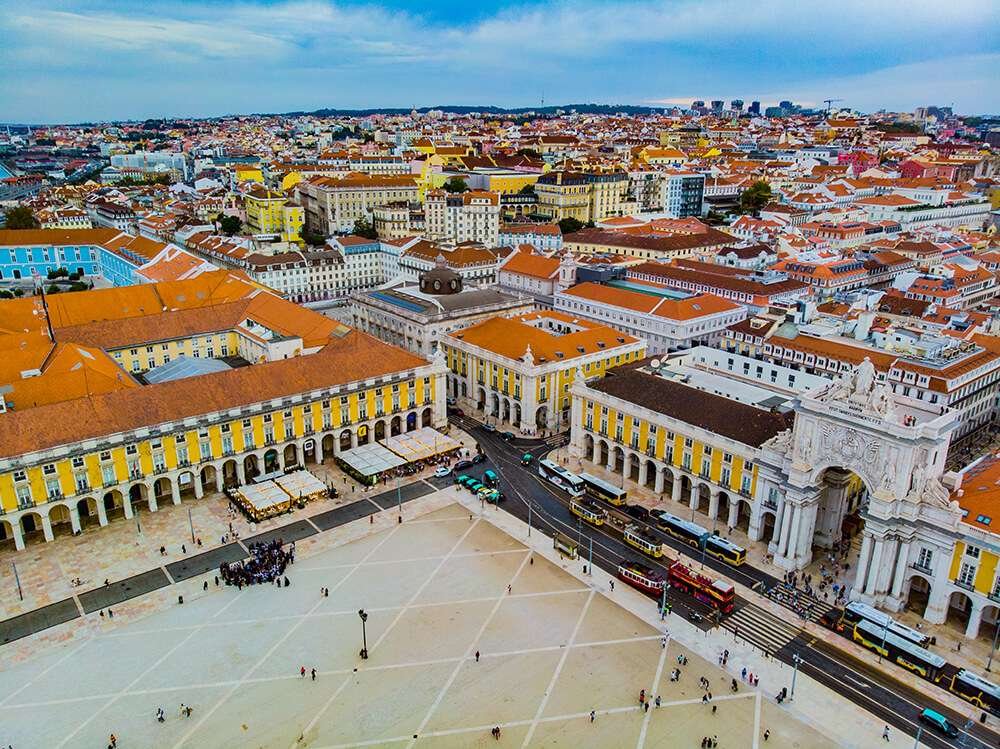
33. Praça do Comércio
The waterfront central square
Located directly on the waterfront, this grand square is the most popular in the city. Lined with bars, restaurants, cafes, museums and shops, Praça do Comércio is like the front door through which you pass to enter central Lisbon.
It was first designed with the purpose of serving as a government district which would regulate the port and customs, giving it the name, Praça do Comércio, meaning Trade Square. In the middle is a monument to King José I and on the pedestal of the statue is an elephant, which represents the power of the Portuguese empire abroad.
- By Tram: 28E or 25E exit at Pç. Comércio

34. Glória Funicular
Ride the famous tram or have your picture taken beside it.
Glória climbs up and down the steep hill connecting Praça dos Restauradores to Bairro Alto. Built in 1885, it was the second funicular to open in Lisbon.
Once powered by steam and illuminated at night by candles, the now electric funicular was designed by Raul Mesnier de Ponsard, the Porto born engineer who had apprectinced for Gustave Eiffel as well as helped design the Santa Justa Lift . If you decide to take a ride on Gloria, you will be met with fantastic views of the city that stretch across Lisbon.
- Address: Calçada da Glória 51
- Getting a ticket ahead of time for Lisbon's Public Transportation can save you time and money.

35. Carmo Convent
Once home to Carmelite nuns, now only the exterior frame remains.
The Carmo Convent was almost leveled in 1755 but luckily parts of the fabulous gothic style building were able to withstand the earthquake.
What was once the largest church in Lisbon is now a roofless nave, with arches that form the skeleton of the remaining structure. The church was built between 1389 and 1423 and functioned as a residential site for Carmelite friars as well as held a large library. Centuries later, Carmo Convent served a significant role during the 1974 Carnation Revolution as it was the point of a political standoff. Visitors to the convent can enjoy the structure, the archaeological museum within and an unforgettable view of the heart of Lisbon below.
- Address: Largo do Carmo
- By Tram: 28E exit at Pç. Luis Camões
- Tip: The best way to experience the beauty of the Carmo Convent is during the "Lisbon under the stars" event. Get your tickets in advance!
36. Scenic train to Cascais
Coastal train which takes passengers to all the beach towns from Lisbon to Casicas.
Departing from Cais do Sodre, the central train station in Lisbon for above ground travel, a train leaves for Casicas about every 20 minutes. Cascias, the upscale beach town at the end of the line, is popular with summer visitors and expats with its exquisite beach lined mansions and castles.
The train ticket, which can be purchased for a single ride or on the prepaid card costs only a few euros and rewards with one of the most beautiful journeys. The line includes 17 stops with more than 10 of them dropping you off at different beaches along the way. If you decide to take the train to the last stop, Cascias, expect to be on board for about 40 minutes. Cascias was once the summer getaway for the nobility of Portugal and while it no longer is, you can still expect to be met with some of the finest restraints, most impressive villas and high end shopping options.
For easy traveling, follow our guide to Traveling from Lisbon to Cascais.
Popular Ticket Options:

37. Tour the Street Art
Discover the paintings and recycled art projects around Lisbon.
The year round ideal weather in Lisbon makes it the perfect city for long walks and touring street art. The walls of Lisbon are home to Portuguese and international artists and boast big works by famous names such as Bordalo II, Shepard Fairey and Vhils.
Bordalo’s incredible murals made exclusively by recycled materials feature multiple-story sized animals constructed onto building facades. Vhils is known for his signature style of carving portraits into the structure of the building. You can find multiple pieces by both creatives around Lisbon. We suggest visiting Bordalo’s Pelicans beside the Santa Justa Lift and the collaboration of Vhils and Fairy on Rua Senhora da Glória. Another great location to visit are the streets of Largo da Oliveirinha and Calçada da Glória which is the city council sponsored “street art gallery” of the city.
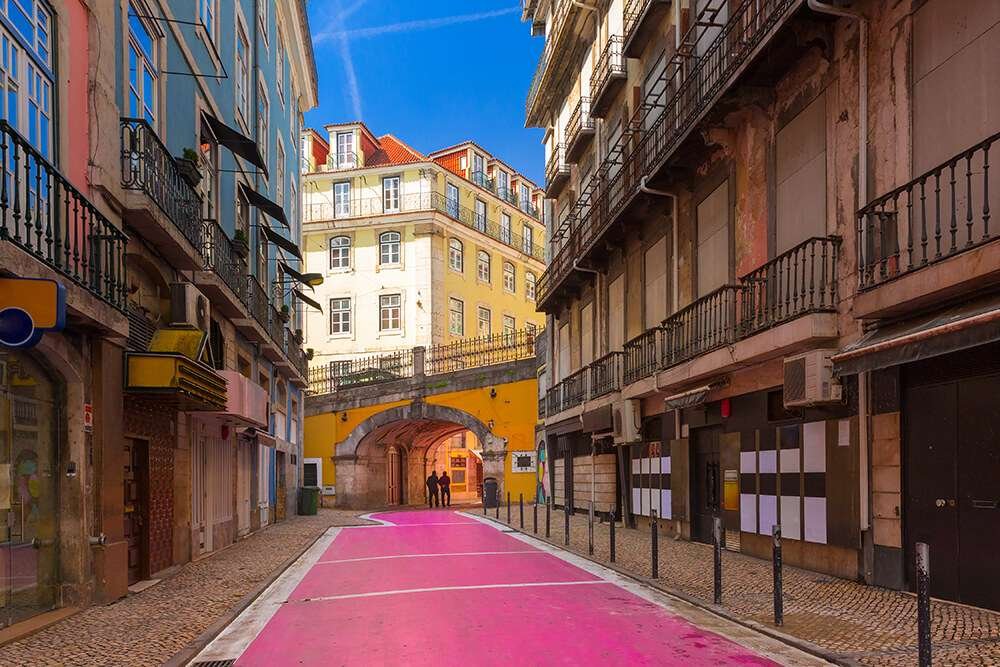
38. Pink Street
Lively bar area and popular photo destination.
Rua Nova do Carvalho is commonly known as “Pink Street,” given that, well, the ground is painted bubblegum pink.
The pedestrian-only Pink Street runs through a tight cluster of bars, cafes and restaurants which overflow onto the sidewalks with little tables placed under the rainbow umbrellas which hang overhead. Aside from partying in Bairro Alto, Pink Street is where you will find music and drinks which last until the morning. Walk through during the day to have your photo taken on the iconic rua and return at night to see it filled with partygoers.
This area is especially sought out by those celebrating their bachelorette and bachelor parties. If you're planning a trip to Lisbon to celebrate, make sure to consult with us for reservations and discounts on hotels in Lisbon.
- By Tram: 25E exit at R. S. Paulo
- Book the popular Pub Crawl with Open Bar and VIP Club Entry with stop at the famous Pink Street!
- Convenience is key when visiting a city. Make sure to book your hotel in Lisbon close to the neighborhoods you plan to spend time in.
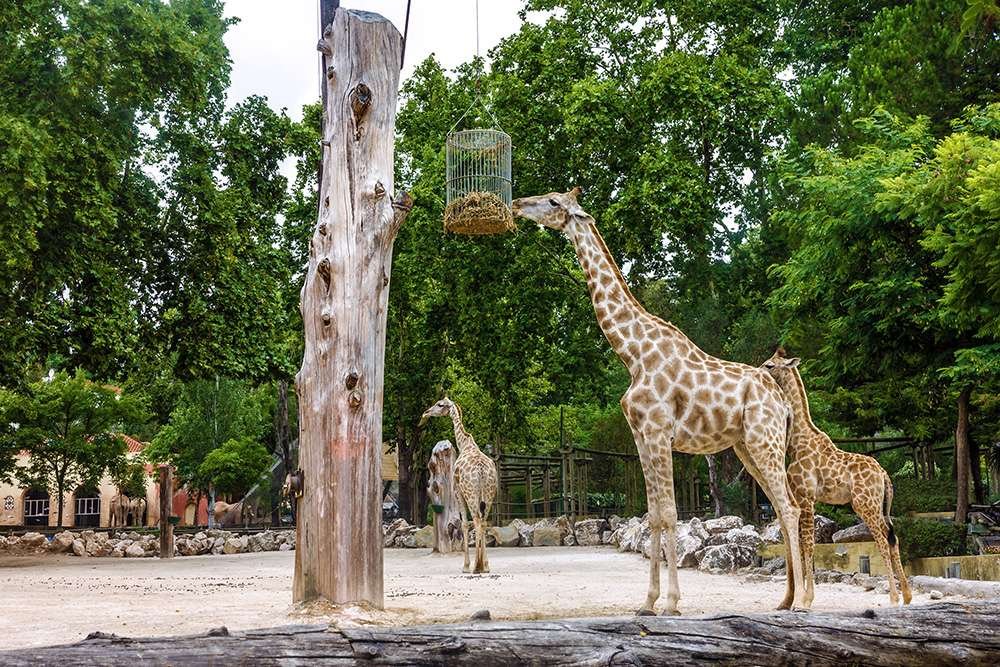
39. Lisbon Zoo
The Lisbon Zoological Garden is the perfect full day excursion.
Complete with large mammals, reptiles, birds, amphibians and even some water based animals, the Lisbon Zoo is great for a full day of entertainment and excitement.
Many features make the Lisbon Zoo a suitable option for those traveling with children, such as the full park train ride and interactive exhibits. Opened at the end of the 19th century, it was the first zoological garden to incorporate various plant and flower species with a diverse collection of animals.
- Address: Praça Marechal Humberto Delgado
- For the best deals on tickets, tours and attractions in Lisbon, be sure to book with us!
- Get your Fast Track Ticket for Lisbon Zoo in advance, and skip the long lines!
40. Archaeological Nucleus in Rua do Correeiros
The site of ancient Roman ruins
Get ready to go underground and discover the history of Lisbon! The ancient ruins contained within this building were discovered in 1991 while the parking lot for the Millennium BCP bank was being built.
In the underground museum of the Archaeological Nucleus you will discover Medieval and Islamic ruins, artifacts, tunnels, a Visigoth burial site, skeletons and the only Roman mosaic found in the city. Archeologists believe that this area was once an ancient sardine factory from the Roman Ages in the 1st century AD, as they have excavated multiple fish-preservation tanks and baths.
- Address: R. dos Correeiros 9
→ The museum is located just beside Rua Augusta, one of Lisbon's Best Shopping Streets.

41. Casa dos Bicos & José Saramago Foundation
Unique architecture and foundation for the Nobel prize winning Portuguese writer.
The 16th century building nicknamed the ‘House of the Beaks’, stands out among its neighbors with more than 1,000 diamond shaped stone pyramids covering the exterior. The Casa dos Bicos was modeled after Venetian palazzos with a twist of Portuguese Manueline style, seen in the arched windows.
Head inside and take your choice of visiting either the José Saramago Foundation or the Museum of Lisbon. The foundation includes his personal library, an exhibition dedicated to his life and work, as well as a venue for events and literary discussions. There is also a garden where you can see the memorial to Saramago- as this is the resting place of his ashes.
- Address: Rua dos Bacalhoeiros 10
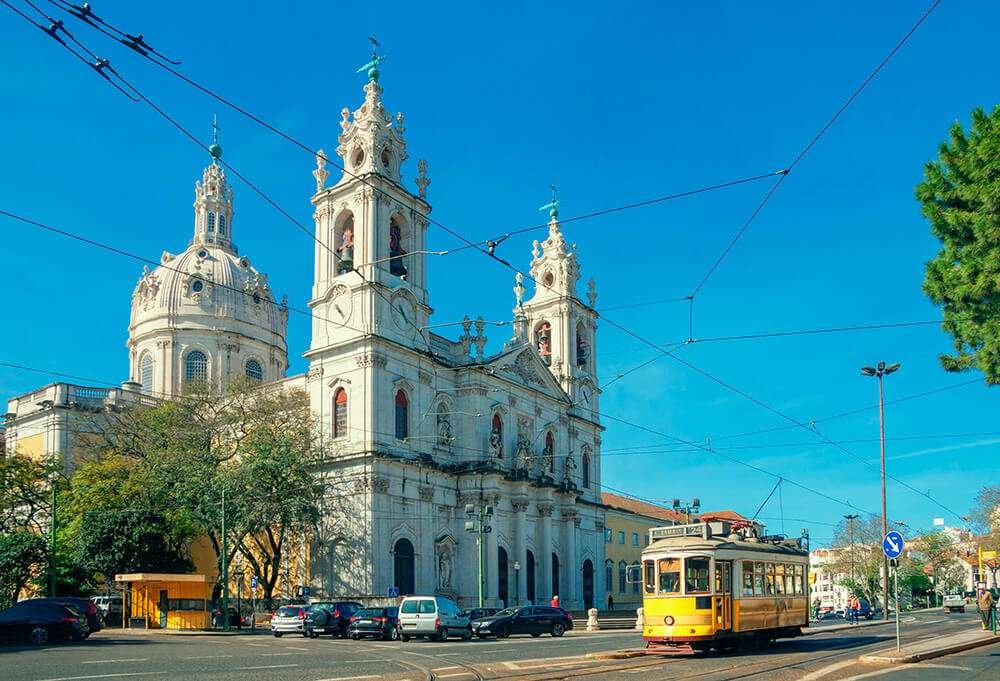
42. Estrela Basilica
The iconic domed royal basilica
The Estrela Basilica can be seen from many points in the city as its rococo dome and twin bell towers reach into the sky.
It was commissioned by Dona Maria I who was the ruling queen between 1777 – 1816 and whose tomb is located here. If you’re interested in a fantastic view of Lisbon from above, climb the 112 steps to the rooftop balcony to see the city and surrounding neighborhoods from a different perspective.
- Address: Praça da Estrela
- By Tram: 28E exit at Estrela Basilica
Estrela is a fantastic neighborhood just slightly outside of the city's center. Using one of Lisbon's Ride Share apps can help you reach it faster, saving you time during your holiday.
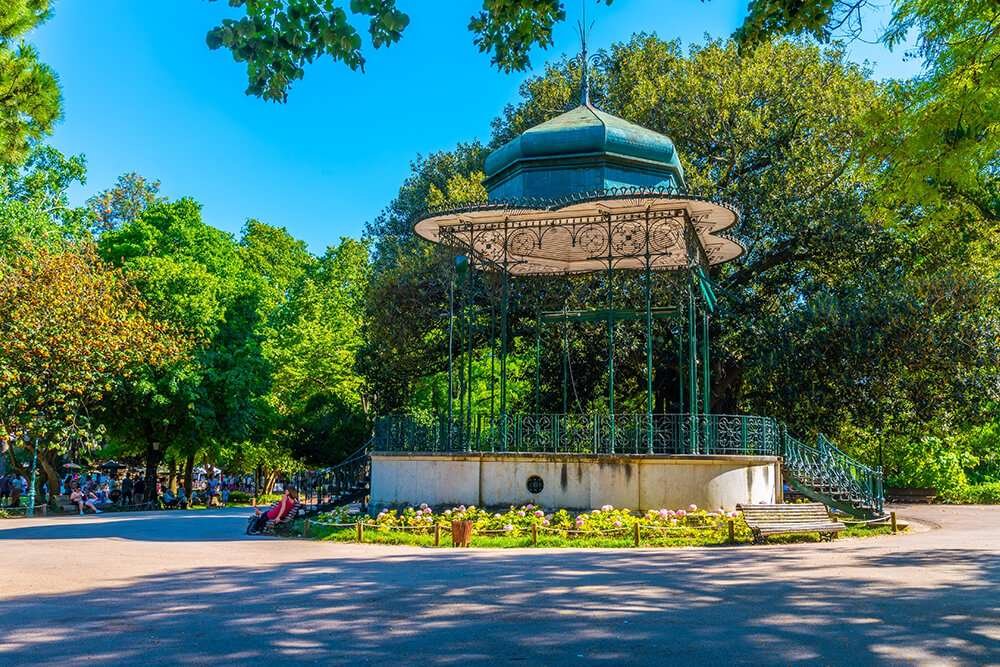
43. Jardim da Estrela
Star-shaped garden featuring tropical plants
Jardim da Estrela is one of the nicest parks in Lisbon and offers a relaxing day away from tourist crowds.
Within Jardim da Estrela you will discover two kiosks, located beside quaint ponds filled with ducks, which sell decently priced drinks and snacks. There is an athletic court, walking paths surrounded with diverse vegetation and a large area for children to play. There is also a third kiosk which acts as a small free library in the park. In the summer concerts and arts and crafts markets are held here and the green spaces become full with people coming to picnic, sunbathe, exercise or meet with friends. It was even once the favorite park of Lisbon’s royal family who came to enjoy time with their children.
- Address: Praça da Estrela 12
- By Tram: 28E exit at Estrela Basilica
- The kiosks in the park are featured in the complete audio-guide tour to Lisbon's Kiosks! Download and discover the history and stories behind these green cafes.
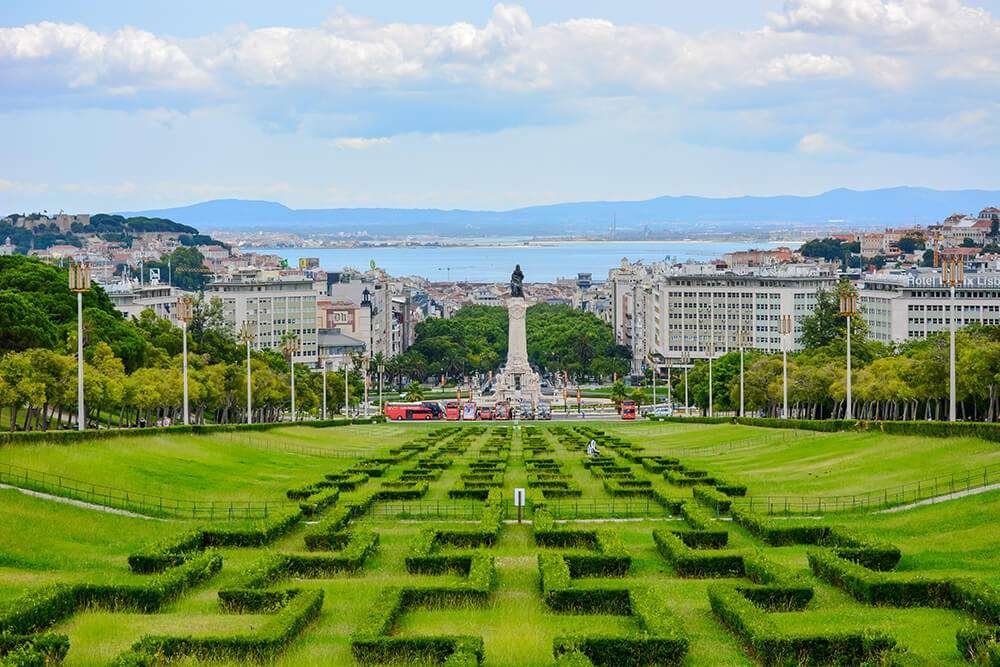
44. Eduardo VII Park
The largest park in Lisbon
This is Lisbon’s largest public park, which occupies almost sixty acres of land. To get the best views of the city, climb to the top of the sloped landscape which offers a clear shot to the river.
The park was originally named Parque da Liberdade but was changed to its current name after King Edward VII of the United Kingdom came to Portugal in 1902 to improve the relationship between the two nations. The landscaping includes box shaped hedges which have been designed to create a patterned mosaic running up the entire center of the park, large walking paths and multiple monuments to royal and political figures.
- Address: Parque Eduardo VII
- The neighborhood of Avenida da Liberdade where the park is located is home to the most stunning Five Star Hotels in Lisbon.
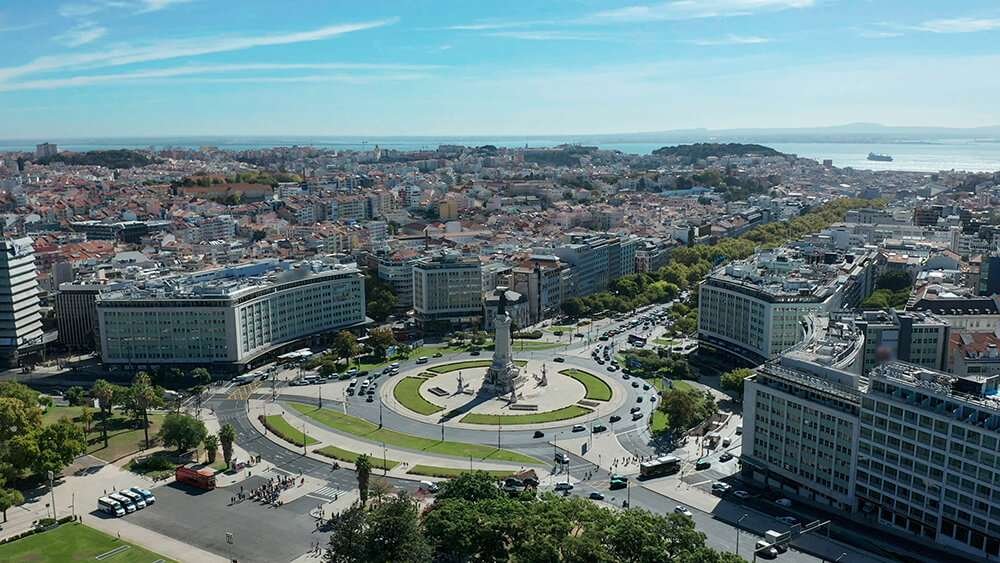
45. Avenida da Liberdade
Stroll along the upscale shopping district
Running directly through the heart of Lisbon, Avenida da Liberdade is a beautiful tree lined boulevard with large pedestrian paths which run alongside some of the most expensive real estate in the city.
Translated as Liberty Avenue, the promenade was built after the earthquake. It was intended as a large green public space but access was limited to only nobles and the elite- with gates even erected to keep commoners out. When the government fell from power in 1821, it was designated as a public space and over the years renovations and additions were added to make it resemble the famous boulevard in Paris, Champs-Elysées. A walk along the avenue will impress visitors with beautiful statues, tropical landscaping, Lisbon’s signature tiled pavement and some of the most elite fashion brands in the world.
- The Best Shopping in Lisbon is here and it's not to be missed!
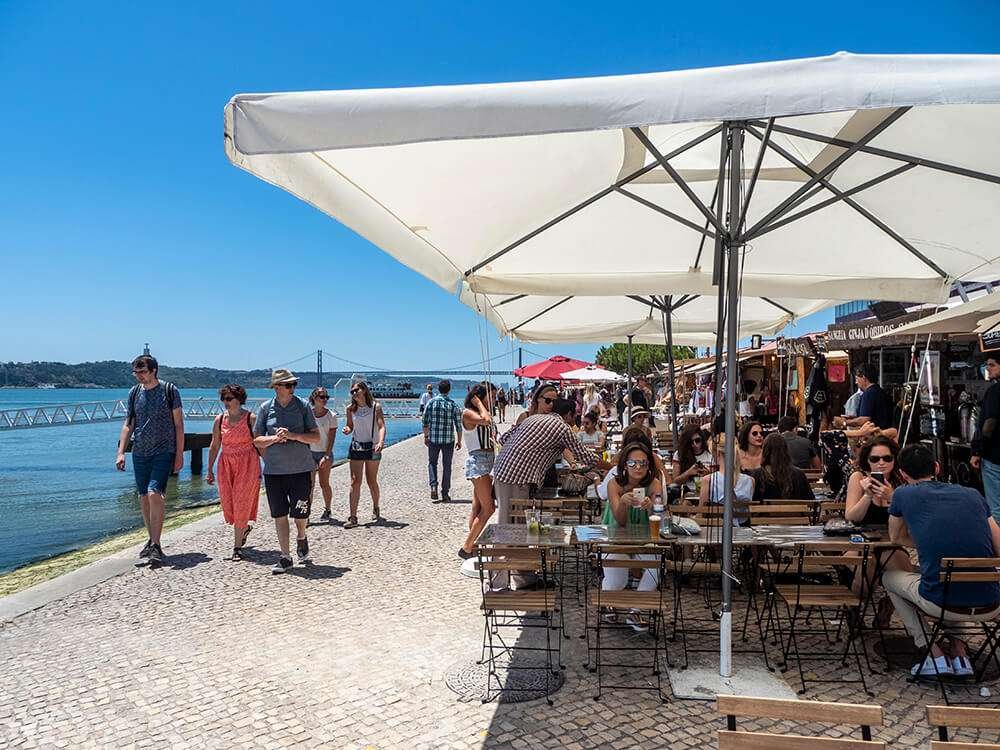
46. Ribeira das Naus Kiosk
Situated along the Tagus River
It's almost impossible to beat the location of Ribeira das Naus Kiosk. Just feet from the river side, chairs and tables are arranged under huge umbrellas, lounge chairs are set directly looking at the river and bridge and dangling strings of bulb lighting twinkle above as the sun sets, creating the most romantic atmosphere.
Located only a few minutes from the main train station and city center, Praça do Comércio, the kiosk is easy to reach and often draws a crowd as live music and DJs are set up during summer. Watch the sailboats glide by, sip a delicious aperol spritz and soak in the unbelievably good weather that Lisbon is known for.
- Address: Av. Ribeira das Naus 5
- Known for its relaxing atmosphere and slow pace of life, Lisbon's Lifestyle is one to be embraced.

47. Monsanto Forest Park
Sprawling park located outside the city with a popular view point
Covering more than 120 acres (50 hectares) Monsanto Forest Park offers a full day in nature. There are walking paths, recreational areas, a children’s amusement park, picnicking spots, a palace, various playgrounds and even campgrounds.
Monsanto Park is an ideal half day trip for anyone traveling with kids as it has, by far, the greatest playgrounds in Lisbon. For those who enjoy biking, Monsanto also offers a variety of biking paths. At the top of the park is a popular lookout area, the Panoramico de Monsanto, which offers not only a sweeping view but also a photo opt for those who enjoy graffiti and abandoned buildings.
- The best way to reach Monsanto is either with a ride sharing app or with Lisbon's public buses.

48. Casa Fernando Pessoa
The home of the famous Portuguese writer
Encompassing three floors of a gorgeous historical building, the museum and home of Fernando Pessoa is on display. It was his residence during the last decade and a half of his life, but became open to the public to view the belongings and poetry of Portugal’s most famous writer.
The exhibits are creativity displayed and intertwine language with art, design and imagination. It’s a powerful work of literary tribute and offers visitors the chance to acquaint themselves with Pessoa as well as explore the global library within the home.
- Address: R. Coelho da Rocha 16 18
- By Tram: 25E or 28E exit at R. Saraiva Carvalho
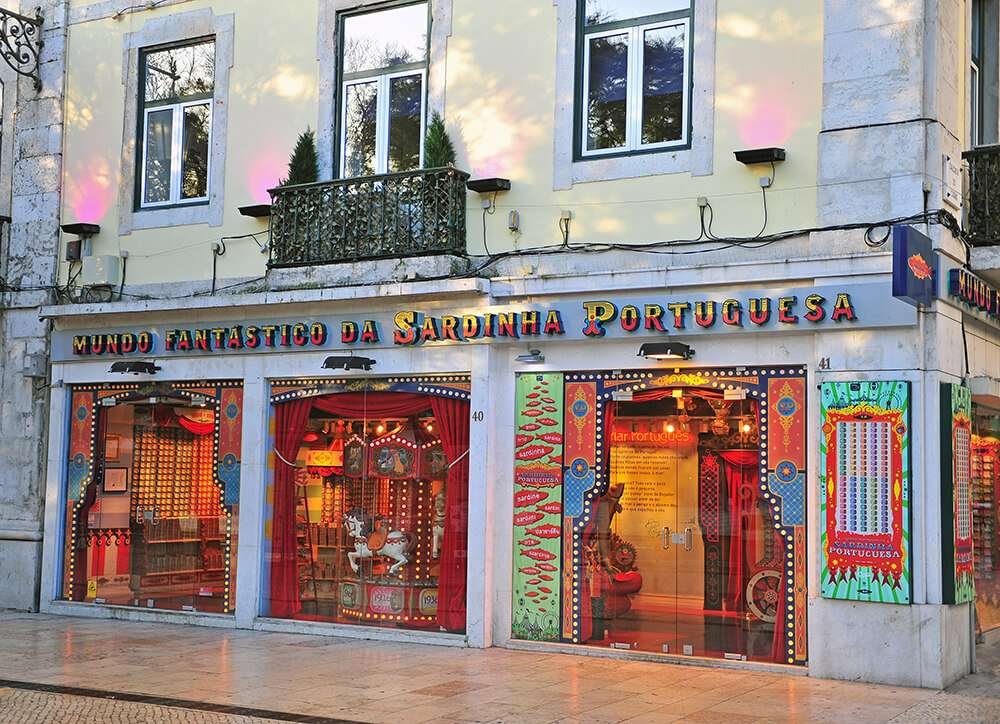
49. O Mundo Fantástico das Conservas Portuguesas
Grab a can of Portugal’s famous sardines.
The carnival themed shop of The Fantastic World of Portuguese Sardines is packed with an assortment of vibrantly colored containers each marked with a different year.
The canned fish packing company Comur prides itself on providing quality products since 1942. All of their goods are assembled by over 100 women who carefully prepare the fish, respecting tradition and history in their methods. You can find more than 30 varieties of canned fish here, some marinated in the most unique spice blends. Each tin is decorated with a lithograph painting of historical significance, making them great souvenirs as well as snacks! Their other stores are The Cannery of Portugal and The Eel Shop.
- Address: Praça Dom Pedro IV 39
- By Tram: 25E exit at Pç. Figueira
- Looking for the Best Shopping and Souvenirs in Lisbon? We’ve got you covered!

50. National Museum of Ancient Art
A vast collection of art representing Portuguese history
Step inside a stunning work of architecture at the National Museum of Ancient Art and explore the treasures that define Portugal's past.
Objects from the Middle Ages to the 19th century demonstrate the global reach the country had and the wealth that was acquired and invested in art. After visiting the museum enjoy the back garden and cafe with a large terrace that overlooks the river.
- Address: R. das Janelas Verdes
Book your vacation at one of Lisbon's Best Boutique Hotels and stay only steps away from the National Museum of Ancient Art.
Popular Ticket Options:
Lisbon Tours & Tickets
Discover Lisbon today with the most popular tours & tickets without standing in line.

